|
Chorale Melodies used in Bach's Vocal Works
Dies sind die heilgen zehn Gebot |
|
Melody & Text | Use of the CM by Bach | Use of the CM by other composers |
| |
|
Melody & Text: |
|
Martin Luther's versification of the Ten Commandments was published first in 1524, with the tune (supra). The latter is an adaptation, probably by Johann Walter, of the melody of the pilgrim song “In Gottes Namen fahren wir.” Besides the three Organ movements in which it occurs, J.S. Bach uses the melody elsewhere in the accompaniment to the first Chorus of Cantata BWV 77 (c1725) and Choralgesänge, No. 66 (BWV 298). J.S. Bach’s text of the tune is invariable. It is noticeable that he writes G for F as the first note of the fourth line of the stanza (the ninth note of the second line supra). Therein he follows Witt (No. 222).
There are three Organ movements on the melody: BWV 635, BWV 678, BWV 679.
Source: Charles Sanford Terry: Johann Sebastian Bach, Bach’s Chorals, vol. 3 The Hymns and Hymn Melodies of the Organ Works (1921), pp 134-137 |
|
"Dies sind die heil’gen Zehn Gebot" (These are the sacred Ten Commandments) is Martin Luther's 12-stanza text using the melody of the German c.1200 folk hymn, “In gottes namen faren wir" (In God's name we are traveling). It is found in Das Neu Leipziger Gesangbuch of 1684 (NLGB) No. 170 (p. 490), under Catechism hymns as well as the omnes tempore Pulpit and Communion Hymns for the First Sunday after Epiphany and the Sundays after Trinity Sunday 4, 6, 13, and 18.
Source: Motets & Chorales for 13th Sunday after Trinity (William L. Hoffman, January 1, 2012) |
|
Melody: Zahn 1951
Composer: Anon (Erfurt, 1524), based on a 15th century melody |
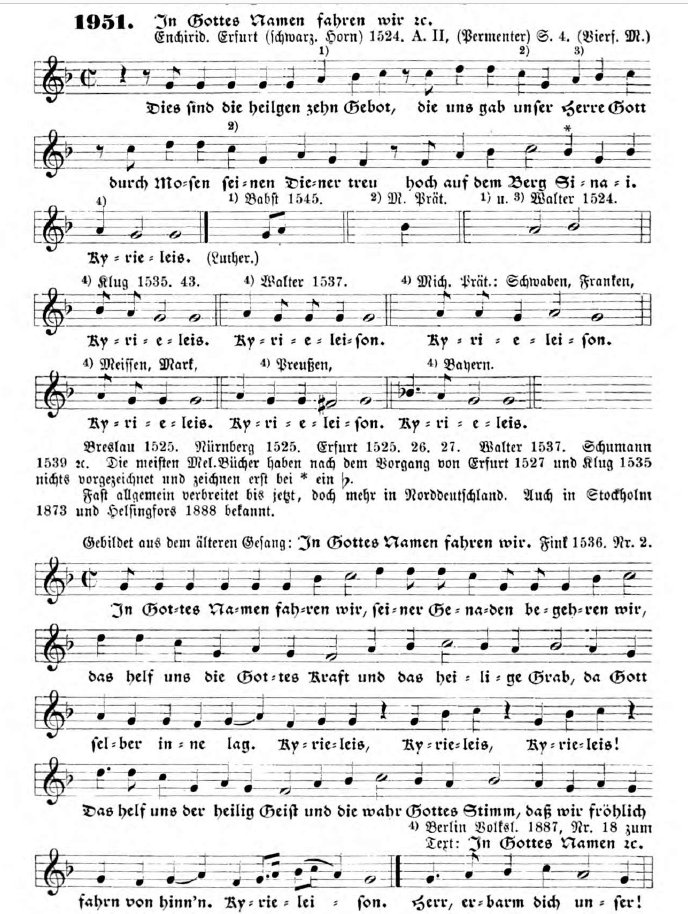 |
|
Text: Dies sind die heilgen zehn Gebot (NLGB 170; EG 231)
Author: Martin Luther (1524): |
|
Hymnal versions Bach may have known: |
|
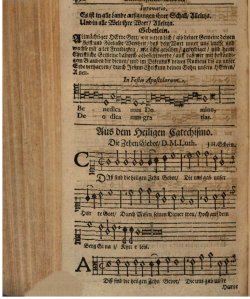
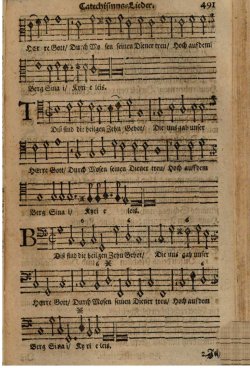
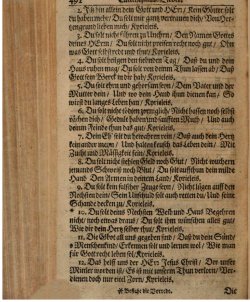
|
|
Melody & text of Dies sind die heilgen zehn Gebot (NLGB 170) from the Neu Leipziger Gesangbuch, pp 490-492 |
| |
| |
|
Use of the Chorale Melody by Bach: |
|
Text: Dies sind die heilgen zehn Gebot |
|
Chorale Dies sind die heilgen zehn Gebot, BWV 298
Ref: RE 127; Br 127; KE 66; Birnstiel 131; AmB 46II p.80 & p.111; Penzel 103; BGA 45; BC F46.1; CST 69 |
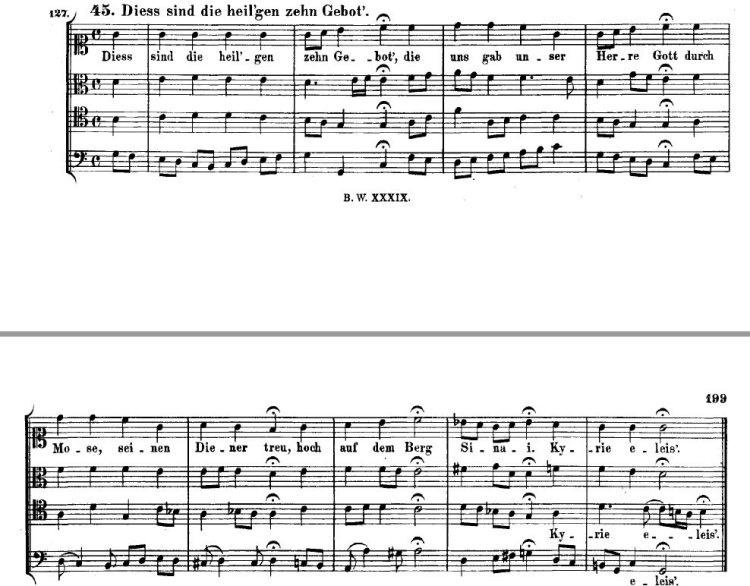 |
|
Untexted: |
|
Chorus Du sollt Gott, deinen Herren, lieben (Mvt. 1) from Cantata BWV 77 |
|
The opening Chorus of the Cantata introduces a Choral melody that does not appear elsewhere in the Cantatas, Oratorios, or Motetts. The movement is a Chorus upon the words, “Du sollst Gott, deinen Herren, lieben von ganzem Herzen, von ganzer Seele, von allen Kraften, von ganzem Gemüthe, und deinen Nächsten als dich selbst” (“Thou shalt love the Lord thy God with all thy heart, and with all thy soul, and with all thy strength, and with all thy mind, and thy neighbour as thyself,” St Luke x. 27). As Spitta comments, J.S. Bach called to mind the continuation of the Scripture text: “On these two commandments hang all the law and the prophets.” He therefore enforces the text by the melody of Martin Luther's Hymn, “Dies sind die heil’gen zehn Gebot’ ” (“These are the sacred ten commandments”). While the Chorus is worked out in quavers from the first line of the melody, the lesser commandment is stated by the Tromba da tirarsi, which announces the tune in crotchets, while the greater commandment is emphasised by the Organ, treating the melody in minims as a cantus firmus.
The melody is an adaptation of the tune of the song, “In Gottes Namen fahren wir.” Reconstructed for M. Luther's Hymn, the tune was published both in the Erfurt Enchiridion of 1524 and in Johann Walter's Geystliche gesangk Buchleyn at Wittenberg in the same year. The reconstruction of the tune may be attributed to J. Walter.
There is a harmonisation of the tune in the Choralgesange, No. 66 (BWV 298). Organ Works, BWV 635, BWV 678, BWV 679.
Form. Choral Fantasia (Tromba da tirarsi, Strings, Continuo).
Source: Charles Sanford Terry: Johann Sebastian Bach, Bach’s Chorals, vol. 2 The Hymns and Hymn Melodies of the Cantatas and Motetts [1917], pp 277-278 |
|
Cantata BWV 77 uses chorales in the opening chorus and closing four-part hymn setting:
Dies sind die heil’gen Zehn Gebot (These are the sacred Ten Commandments) is Martin Luther’s 12-stanza text using the melody of the German c.1200 folk hymn, “In gottes namen faren wir" (In God's name we are traveling). It is found in <Das Neu Leipziger Gesangbuch> of 1684 (NLGB) No. 170 (p. 490), under Catechism hymns as well as the <omnes tempore> Pulpit and Communion Hymns for the First Sunday after Epiphany and the Sundays after Trinity Sunday 4, 6, 13, and 18.
Source: Motets & Chorales for 13th Sunday after Trinity (William L. Hoffman, January 1, 2012) |
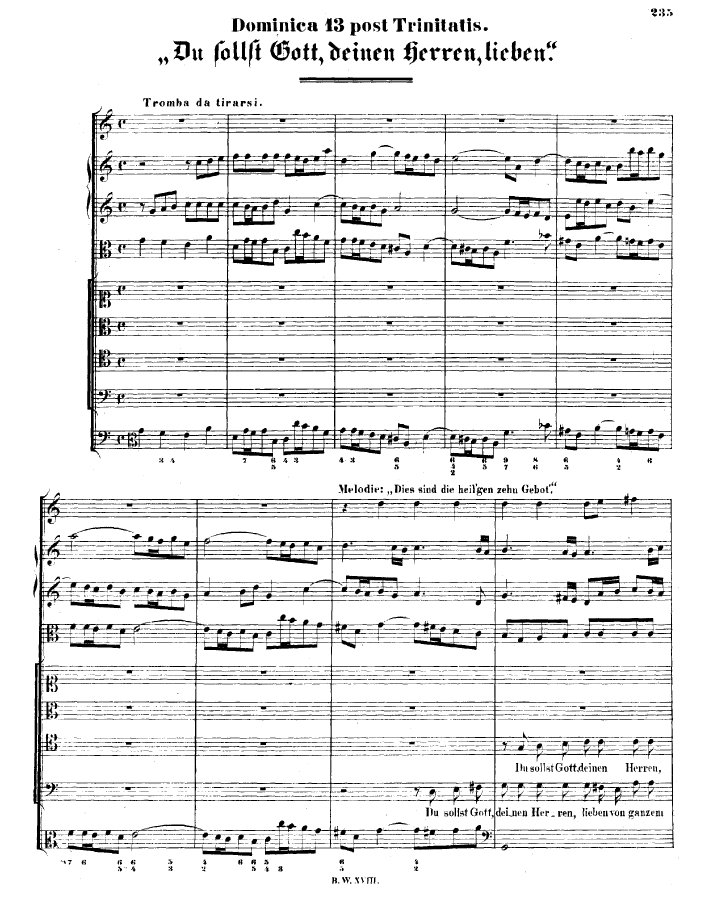 |
|
Chorale Prelude Dies sind die heilgen zehn Gebot (I), BWV 635 |
|
The movement is the first of the Catechism hymns in the Orgelbüchlein. It is one of three there—the others being N. xv. 39, 115—in which J.S. Bach evolves the figures of the counterpoint out of the first line of the tune3. In the present instance the device assists his love of literalness. In the two inner parts that accompany the cantus and on the Pedal he introduces the first melodic period of the tune with constant iteration to suggest the rigidity of rule and dogma1. |
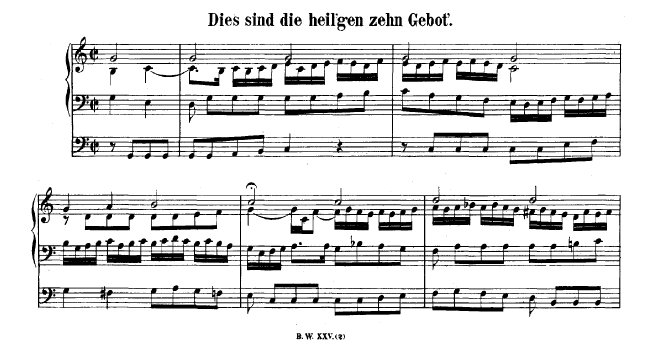
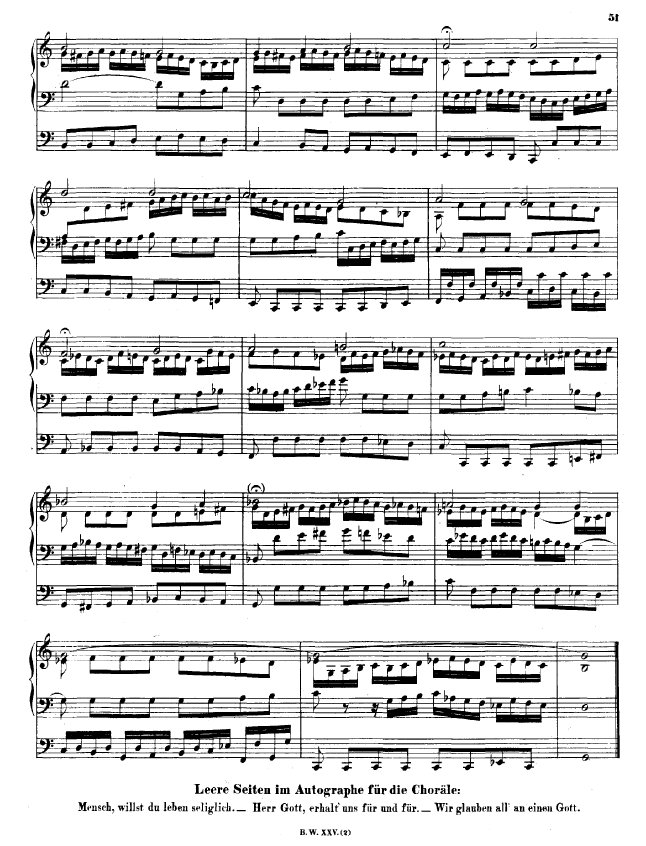 |
|
Chorale Prelude Dies sind die heilgen zehn Gebot (II), BWV 678 |
|
This and the following movement belong to the Clavierübung, a work in which J.S. Bach tended to indulge in symbolism somewhat extravagantly. His purpose here is to illustrate and enforce the idea of law and of man’s bondage to it as a necessity of his moral being. To quote Schweitzer’s penetrating analysis2: “In a lengthy fantasia each of the separate parts goes its own way, without rhythm, without plan, without theme, without regard for the others. This musical disorder depicts the moral state of the world before the law. Then the law is revealed. It is represented by a majestic canon upon the melody of the Choral, running through the whole movement.” J.S. Bach had the same idea before him when he introduced the melody into the opening Chorus of the Cantata BWV 77, “Du sollst Gott, deinen Herren, lieben” (c1725). |
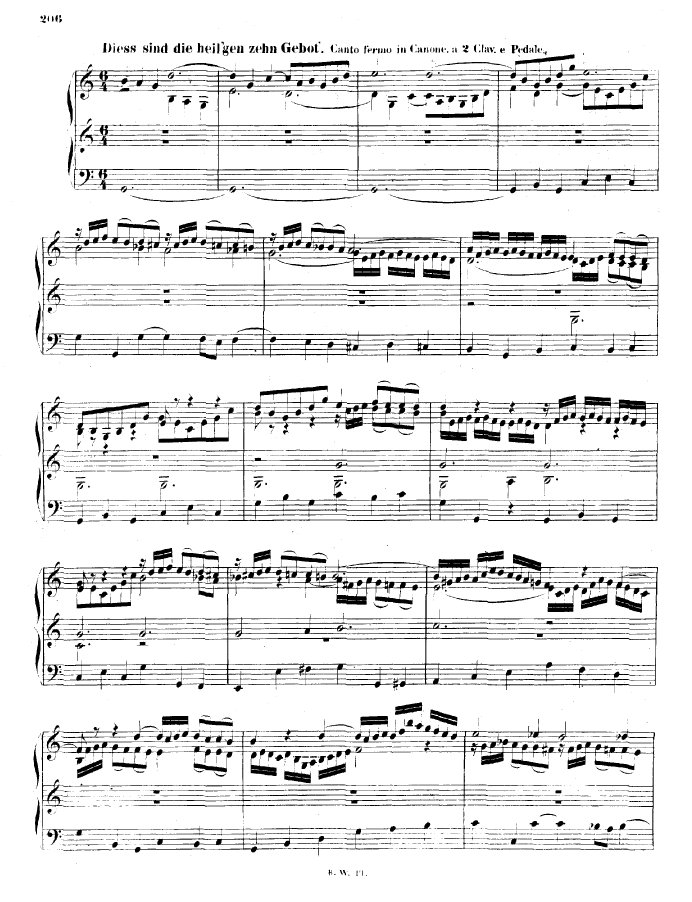 |
|
Chorale Prelude (Fughetta super) Dies sind die heilgen zehn Gebot (III), BWV 679 |
|
The movement belongs to the shorter set of Clavierübung Preludes. It is a Fughetta, in which a counterpoint upon the first line of the melody is carefully stated ten times. |
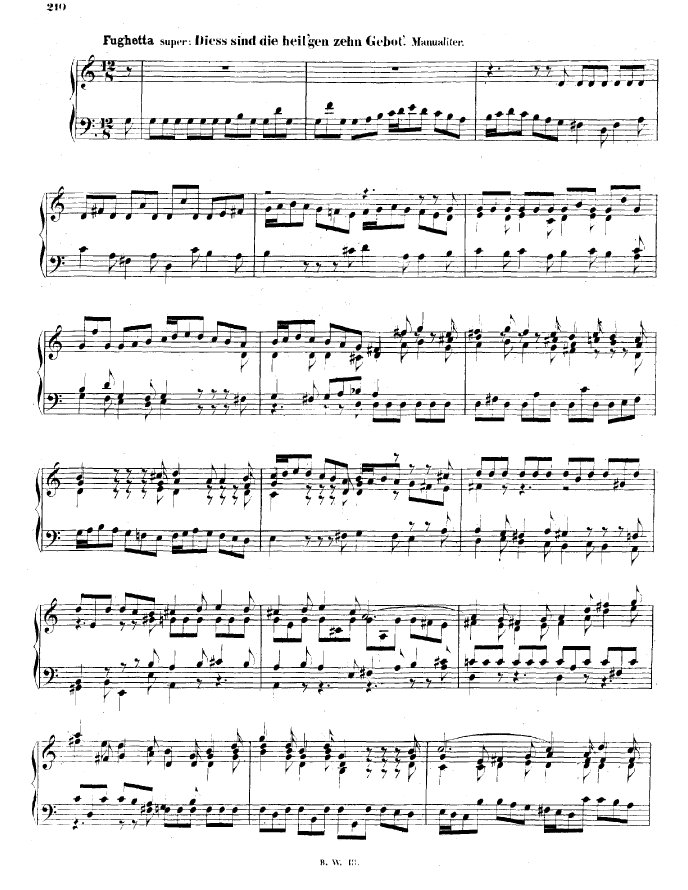 |
| |
| |
|
Use of the Chorale Melody by other composers: |
| |
| |
|
Sources: Bach Digital; BGA; Zahn
Photos from Gottfried Vopelius Neu Leipziger Gesangbuch (Vopelius 1682), were taken from a digital copy of the book downloaded from Bayerische Staatsbibliothek München. This copy is Out of copyright - non commercial re-use (Europeana Rights).
Prepared by Aryeh Oron (October 2018) |